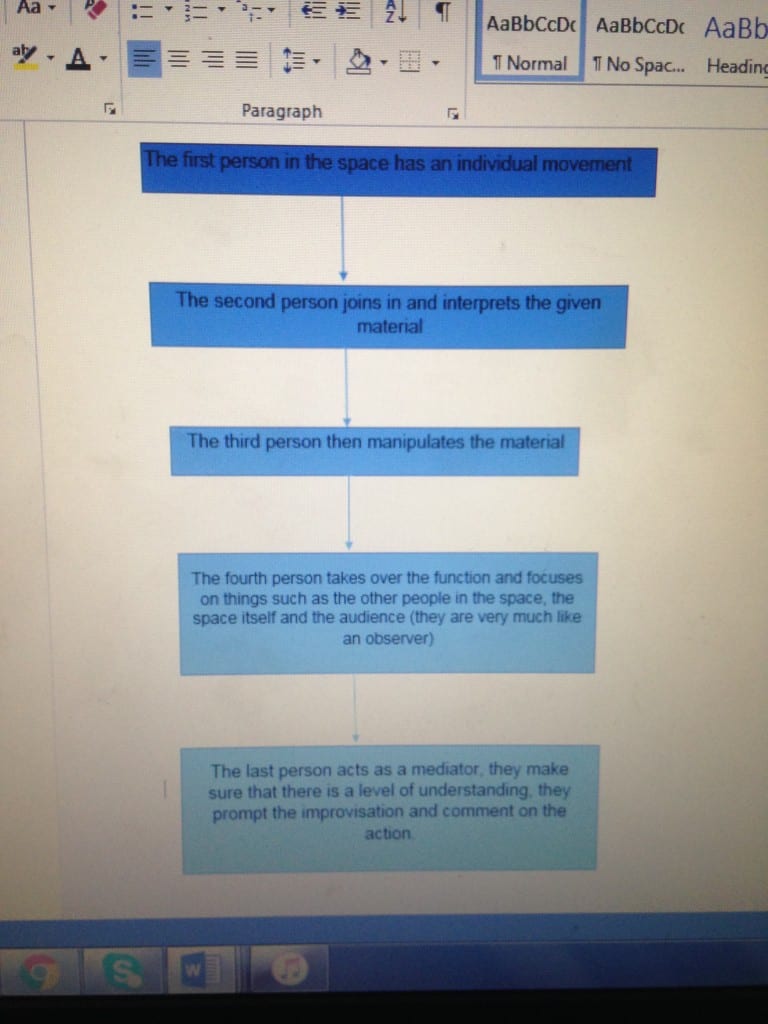To start this week’s class, we did a swiping exercise working in partners swiping our arms out to the side, to the bottom corner of our bodies and to the top corner of our bodies. If our partner did the same movement we had to do a corresponding movement. This exercise focused on transference of weight as well as how well we could work together with peers.
We then began travelling the exercise, A’s walked into the space doing the same arm movements as previous, B’s had to weave their body around the arms in different ways.The movement began to get repetitious and I really had to think of new ways in which to intertwine my body around their arms. We repeated this exercise with our eyes closed. When I was moving around their arms, I found it a lot harder to predict the arm movements thus sometimes colliding with my partner. When I closed my eyes I noticed I restricted my arms and slowed the pace of the movement down to make it easier for my partner.
Before going into the next exercise, we walked around the space with our eyes closed, only opening them to take a brief ‘snapshot,’ of where other bodies were in the space. To begin with I found this exercise quite easy but I clearly wasn’t challenging myself enough as I could, I began testing it further keeping my eyes closed for a longer duration and weaving around the space and found that in a number of situations, I was becoming more close and having to dodge other people. We then put the idea of the brain taking snapshots and this idea of ‘backawards blinking,’ into practice working with partners improvising across the space.
For the next exercise we traveled across the room improvising our own movement whilst our partners copied. I found it really interesting copying other people’s improvised movement and really liked working with new members of the class and seeing how unique each person’s movement was to them. This exercise focused on exploration and I tried challenging my partners as much as possible using hand movements and floor work in my improvisation. I noticed some habitual movements began to occur as people began to repeat other peoples movement. At first I noticed that I paused for thinking time in this exercise as I began moving too fast, but once I felt more comfortable working with new people and slowed my movement down this decreased. We were then asked to close our eyes and follow our partners across the room using this idea of the ‘snapshot.’ Because of this, a lot of movement they improvised got missed and we had to predict what their next movement would be. When observing this exercise, it was interesting to see how different the movement looked when they had their eyes closed, it looked almost nothing like their original improvisation.
The last exercise was an impulse exercise, we began by working in partners touching different body parts which acted as a impulse to improvise. We had to do this without having any thinking time whatsoever. We then did the same exercise but with imagery. We had to improvise as if we were:
-Sea weed
– A kitten
– A wrestler
When trying to embody being seaweed a lot of my movement was relaxed using a lot of floor work in my improvisation and weaving movements replicating the shape and texture of seaweed. When I was giving points of contact to my partner with the kitten imagery, I would touch areas of the body that kittens would most likely use, when I was the improviser I found myself padding my hands on the floor following the particular feline traits of a cat. When improvising being a wrestler the dynamics completely changed, my movement was a lot more fast paced and impulsive striking my arms around my body and rolling around the floor almost as if I was in a wrestling ring.
I found learning about Thomas Lehmen’s score in this week’s reading really interesting and looked forward to putting it into practice. We learn about three choreographic systems in the reading, these are:
- Categories
- Functions
- Its better to
This is a brief diagram explaining Lehmens score:

After watching a video of Lehmen’s score being put into practice, it visually helped me to understand his score and imagine myself in the space doing it. Lehmens “openness of the systems includes a possibility of surprise.” (Husemann, 2011, 33) This quote has made me want to fully explore the score and really try working with it to improvise unique and new movement. I think the openness of the score gives me a real chance for this exploration as there are no limitations to the movement.
In these past couple of sessions we have talked about empathy quite a lot in relation to our improvisation practice. It has been described as a “process that enables the understanding of emotions and intentions among people.” (Ribero, M and AGAR, F, 2011, 73). Empathy is so critical in improvisation especially when working with other people because without building up a relationship in the performance space with other bodies around then the improvisation wouldn’t be as successful.
I really enjoyed this session and look forward to working with Lehmen’s score next week!
Bibliography:
Husemann, P. (2005) The Functioning of Thomas Lehmen’s Funktionen. Dance Theatre Journal, 21 (1) 31-35
Schreibstuck-Vancouver (2010) Available from https://www.youtube.com/watch?v=3EaaFKu3_Y8 [accessed 9 March 2016].